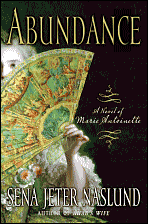
If you think Marie Antoinette said, “Let them eat cake,” you’re wrong. If this sentence—“If they have no bread, then let them eat cake”—was ever uttered at all, it probably issued from the mouth of one of the mistresses of Louis XIV, who lived a century before Antoinette. Like Cleopatra of Egypt, Marie Antoinette has suffered the slanders and calumnies of her enemies. Like Cleopatra and also like Elizabeth I of England, Antoinette showed great concern for the welfare of her people. She could have, like them, been a great queen. This novelization of the queen’s life by the author of Ahab’s Wife (also highly recommended) opens in 1770 when Maria Antonia Josepha Johanna von Habsburg-Lothringen, fourteenth child of Hapsburg Empress Maria Theresa, is journeying to France to be married to Louis Auguste, Dauphin of France and grandson of Louis XV. The girl has been raised by her mother, who was probably the wisest woman in 18th century Europe, to be given to France to cement a political alliance, and so she begins a new life with the royal court in Versailles. It’s a life of luxury that even Paris Hilton would envy, and the teenage Dauphine is as extravagant and about as bright as the modern rich girl. She can play the harp, she can dance, she loves to gamble, she loves the theater, she and her young husband love to hunt. Naslund’s use of historical detail, plus the letters Antoinette and her mother exchange, present an unforgettable picture of the French court. We’ve seen the paintings of the extravagant wigs and fashions, the exquisite Sevres porcelain, the Hall of Mirrors, Le Petit Trianon. Accompanied from lever to coucher by the nobles of France, Louis and Antoinette have nothing to do but play. They’re idle and uneducated. No one has taught them anything about sex (which explains why Antoinette is a virgin seven years into her marriage) or politics (which explains why the well-meaning Louis XVI becomes such an inept king). But Antoinette tries to do the right thing. She’s a good Catholic, she refuses to speak to Madame du Barry (mistress of Louis XV), she endeavors to consider the welfare of the common people (whom she almost never sees), and when the marriage is at last consummated, she becomes a devoted mother. Half-way through the book, she comes upon a seamstress hiding behind a curtain and holds a brief conversation with her. “I raise my hand to delay her removal, in the hope that she will speak first,” the Dauphine tells us. “‘The end of an era approaches,’ [the seamstress] says simply….” It was indeed the end of an era, and even though we know how the story ends—the storming of the Bastille on July 14, 1789, the imprisonment of the royal family in Paris, their attempted escape in 1791, their capture and the abolition of the monarchy, the Terror—Naslund’s skill at story-telling is so great that we just can’t put the book down. It ends with Antoinette’s final thoughts on October 16, 1793, as she faces the guillotine:Through a crack between the planks—a man squats beneath on the balls of his feet. He has the dirty, upturned face of madness. Ah, he is waiting to bathe in my blood. I meet his wild eye. The sled slides forward—the basket—no need to hold on—I open my hands resting on the small of my back—the basket—I had friends, loving friends (I am not afraid). To double-check the details of the history of 18th century Europe, go to Wikipedia or Will Durant. To see the historical icon in action, watch the 1938 movie starring Norma Shearer (this was Eva Peron’s favorite movie and inspired her to dye her hair blonde). To witness the growth of a naïve girl to a woman who would have been a great queen, read Abundance. Like the queen’s friends, you will grow to love her. ~review by Barbara Ardinger, Ph.D.by Sena Jeter NaslundWilliam Morrow, 2006pp. 530 pages, $26.95.
